
By Orhan Ayyuce
#1 Double Take
In a coincidental trespassing situation, I proposed to do an article to Mr. Rotondi on him, he said okay.
The first part of my work takes a place in the school where I 'observe' the class he teaches and I record my takes on tape and on paper.
A day after that, we meet for my interview-turned-conversation in his office, during which he reflects on teaching, life, work, and future, and just about everything else.
He talks clearly, even as I try to distract him with my discontinued questioning and personal inserts.
He was patient with me and did not mind that I talked about myself a little too.
#2 Salk Institute in the Classroom
His office manager tells me to meet him at the "pit" in SCI Arc.
I get there, and ask about the pit and get conflicting directions from couple of students and eventually I find the 'studio' with my own intuition, about half a mile later, sitting around an oblique table and few pin ups on the wall. The hitchhikers to architecture are ready to learn.
The pit, actually, is a long corridor, an interior highway that connects the entire school, metaphorically and literally.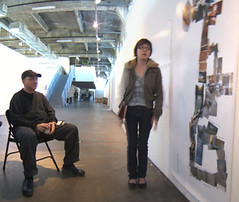
They are in early stages of designing 'A Botanical And Food Garden Complex in Frogtown'. The site is not too far from the school on East side of the Los Angeles River. This is the main project for this semester. They are learning and experimenting with; how to apply storyboard mode of cinemagraphy by way of montage with some suggestions on how to do it (from the syllabus).
At this point, the students are to explore their choices by looking into programmatic elements such as ; research, grow, cook, sell, administer, live, arrive / depart, community. They are there to help imagine / visualize the program (also from the syllabus).
For the starters, the class is asked to group visit and make a storyboard dissect of an early Morphosis-Venice 3 house in Venice, Ca., owned by Ann Bergren who is also co-teaching today.
At one point Mr. Rotondi asks me what 'I' think of the filmic storyboard business, I say,
"I'd let the students in the house one by one at fifteen minute intervals, instead of a group visit."
Pass that, they do not ask me anything again which is better for me anyway. I was not a guest critic; I was working on a story myself.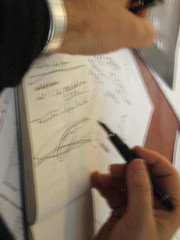
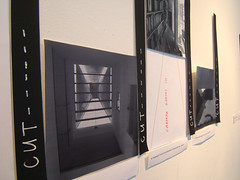
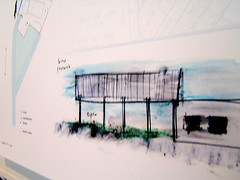
Teaching and learning is a fluid activity to observe in Michael Rotondi's class, I find out.
In his vertical studio, he takes notes into his sketchbook as the students sit around the table.
While talking about jump cuts of architecture, he offers this vignette about experiencing Louis Kahn's iconic Salk Institute. They are the verbal sketches of, approach-arrive-transform, however you cut it.
"You are driving on the roadway in La Jolla and you turn into the gravel driveway and that's when the sound changes... You stop the car and hear the last little skid of the tire on the gravel.
You open the door and step out and you hear your shoes are hitting the ground.
Seconds later, you walk onto different surface and the sound changes again. This time your steps are crushing the leaves on the ground and light filters in through the tree branches.
You are at an oblique point near the entrance gate and the stairs; you still do not see the courtyard.
You turn frontally to enter and you go up a few steps then you see the channel of the water right down the middle, in symmetry with the buildings on both sides. Your eyes follow it and immediately your mind superimposes that on the ocean itself, so it goes 'boom' and you are out to the horizon and any thought you had up to it, evaporates."
He adds,
"Your thoughts are just too tiny at that moment and you have drawn into the shot. If you sit there for couple of hours as I did, you see light and shade, people traveling the courtyard and you can pick out who are familiar with the building from the way they cross over the water.
The building becomes so static, it allows you to see the world around it, changing and moving.
Therefore, the life itself is the variable, and the architecture is constant."
Early into the Frogtown project, he brings in the element of nature and the man-made.
His words are spoken diagrams, skillfully offered to his students.
He has been teaching most of his life. It is the main platform of his work.
He can balance the static and the moving in his mind. He employs this technic a lot in that teaching context.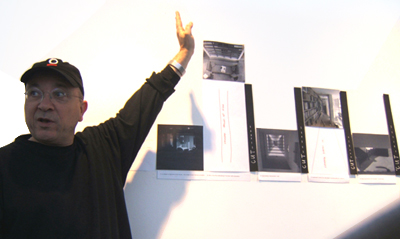
Later, the conversation among the students and the faculty turns into discussions and anecdotes about water, indoor drainage channels, and water penetration jokes from above and below the buildings.
A student asks Rotondi if he has ever repaired any of his own buildings.
"Only if it leaks," he answers, and adds, "even the bad architecture leaks."
#3 This way Mr. Rotondi
The day after the school, I am at his office and open the conversation,
OA: How different is SCI Arc today? You were one of the founding students who became the director later.
MR: (in summary) "It is now different. In addition, my term was different from Ray Kappe's. Each person tries to put a bit of him or herself in the structure. As long as the school does not forget it's
genealogy. SCI Arc is a great school. It has changed and now evolves with the city of Los Angeles."
At the end of his answer I realize, I have not pushed the record button on the tape in the correct way. Not to worry, the subject matter, SCI Arc, appears and disappears throughout the interview.
~~~
I ask him what is important.
He tells me a Lakota creation story, which he heard from tribal people he has worked with. In it, there is a reference to horse. Even though it is thought to be the horse arrived in North America with the Spanish, in the story, there is this same word in the tribe's language for horse and dog.
The horse was always there, but, not in the 'same form'. In their story, the Lakota boy goes behind a hill with his dog and comes back with the horse.
The dog grows into a horse.
The dog became a horse.
It is the same word for the both.
They work the evolution into their creation story. That interests Rotondi, he continues,
"Where I came from, the creation story remains static. And it is interpreted not necessarily for the good of everyone."
Mr. Rotondi is the youngest son in a family of working class immigrants from Southern Italy.
I mention the possibility of horses arriving through the Bering Strait and afterwards not surviving the weather on the way South. It may very well be they survived in name only. Is it a possibility that the horse first appeared with Central Asian riders carrying their triangulated kilims similar to Navajo rugs?
We talk about nomadic cultures and oratorical societies in passing.
"What is important?"
Evolution and movement is important, growth is important.
He hands me a chart he has just written on his tiny sketchbook. Across the wide conference table, he shoots me four diagrams during the interview, like little telegrams.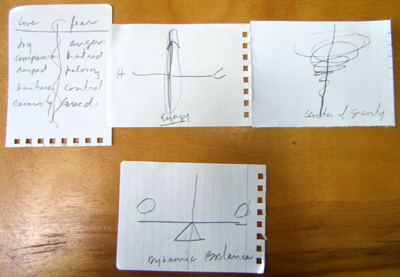
Love/fear chart
Cardinal diagram of Energy
A drawing for Dynamic Balance,
And a center of gravity sketch.
These are universal concepts. These are seemingly simple diagrams containing a lot of information.
These are the guidelines.
The conversation slides. We talk about earth based cultures which pass on the information about 'the sacred inside of us', to future generations, sacred as in animist tradition.
He says, "We lost faith temporarily, and we no longer have a story. The end game is selling to Google..."
I step in,
OA: What has all this we just talked about have to do with architecture?
MR: "It is about trying to keep certain values present. It is about what is your worldview."
He pauses for a second and continues,
"Physically, my work is also about modulating the balance. It is like making two varied speed approaching objects meet at the same speed. How do you do that? You do it thru visualization. That is how you approach a program. So instead of the program being; where do you sleep, where do you bake bread and where do you have the conversation, it is about how the body moves through the space. And what are the variables while doing it?
It is how you modulate the space. How you move in
it and how you picture space in varied speeds."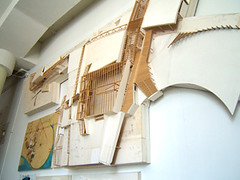
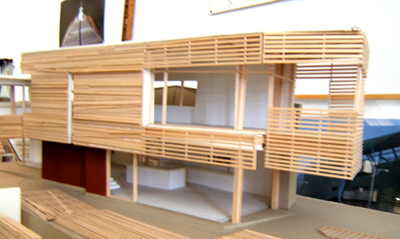
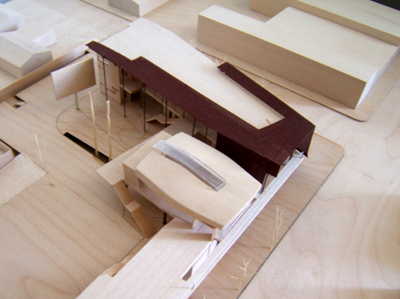
His answer leads me to think that he eliminates the seams between ephemeral and the static.
Clearly, Mr. Rotondi spends a lot of time setting things in motion and than modulates them.
Explanations to his dynamic buildings, roof forms, diagrams of his spatial arrangements start to appear in my mind. This way Mr. Rotondi.
I say to myself, "this is how he designs."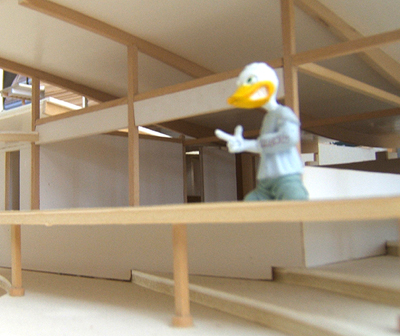
#3a Details on teaching
OA: What do you teach?
MR: I grew up less verbal culture. I can picture things in my mind and visualize things physically moving. This is the upside of growing non-verbal. The words were less available than the pictures in my head. For me it is about going from picture to idea. It is going from experience to concept.
Like, being in a direct engagement with your body and senses and then going back to the idea. It reminds me of a diagram of hand and brain where equal number of nerves goes to brain and to the hand. So when you touch something you recollect every other similar thing you have touched before. The memory is present here. What happens is, if the amount of memory and amount of sensing is equal, you experience something new. If the memory is greater than the sensation, you have predetermined what it is you are going to experience.
I talk to the students about that in a whole variety of ways.
OA: What else comes up while teaching?
MR: In school, architecture happens to be the only thing we are able to do. The context of doing 'that' architecture is everything else. It is the full extent of our personality, emotional intelligence. Everybody has to understand the context in which we exist in his or her own terms. Where do you place yourself in this territory? How do you understand your value systems? Again, what is your worldview?
And, it is not just saying, "gee, this thing looks cool."
OA: How do you describe your interaction within the context of people?
MR: I do not think my own experiences are that unusual.
I like to be around the people who have certain values I can identify with. I am like Geiger counter when it comes to picking up kindness and generosity. It does not only have to do with kind of friendships but also with kind of clients I am willing to accept into my life. I do not take work just to take work.
OA: Do you turn down work?
MR: The way I turn down projects without having to say no, is to present the work in a certain way in public. I try not to second-guess myself. I am not talking about things in order to be strategic from a business point of view.
#3b Zero as infinity's twin and SCI Arc is a Ninja
Michael Rotondi was one of the school's founding 'students', which was started from a simple question;
"Why don't we start our own school?"
In 1972, they started.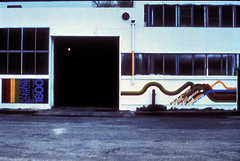
Shortly after his graduation, he became a faculty member and joined with Thom Mayne as principals, thus Morphosis.
He became the second director of SCI Arc after Ray Kappe and further expanded the idea into the international stage.
Those were the most critical years of the institution from the survival point of view and Mr. Rotondi had to make a series of decisions, which have resulted in the school becoming more recognized than ever and breaking some hearts in the process rather unwillingly. It had to be done that way.
In retrospective, a majority of the greater SCI Arc community agrees that Michael made the right decisions.
It must have been very hard to maintain the soul while changing the skin.
Only the true leaders can do that progressively.
Out of all four SCI Arc directors, Rotondi had the most difficult job. The School was born under Ray Kappe, and it has learned how to walk and talk under Rotondi.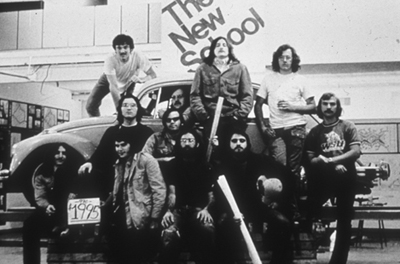
OA: How does SCI Arc operate?
MR: SCI Arc attracted people because of what it was, not because what it 'said' it was. So it attracted certain people from the day one, it opened its doors. SCI Arc operates on self-selection process.
The school showed me how that works. As it started to define itself, one could see how it evolved, it is a constantly changing place, and it is always in a transformative state. It is a very fluid situation.
The fact that it was never able to say, this is exactly what I am, and this is exactly what I am going to do on one hand, created some confusion, but on the other hand, it has allowed it to stay open ended.
SCI Arc has always been, as much as being a social experiment, an educational experiment. Still to this day, the school attracts a specific group of students. They are there because of the stories they have heard about the place and it resonates inside of them.
Most students are in SCI Arc because of what is in their heart.
OA: For me it was like that in 1978. The door was open and I got in. That door still remains open, I gather. The first night I was there, somebody tried to sell me an out of print book called Zig-Zag.
MR: Must have been Tim. Was he?
OA: No it was Roger
Conversation slides again. This time we start talking about numbers. Zero, to be precise. I mention my shared fascination with it and he presents me with couple of books on it.
"Zero is a dangerous business", I said.
He laughs for the first time and adds, "Zero is infinity's twin."
It is my turn to laugh. We were both quoting Charles Seife.
He continues with, the center of gravity, the philosophy of hot and cold, the balance. He revisits the telegrams pictured above.
He brings his words to war and peace to connect to that, "when men in charge we have war, and when women in charge we have peace", as he was told that tale by couple of Lakota elderly women of Rosebud Reservation he worked for.
He is all for matriarchal society and thinks there is hope and historical precedence for it.
Through his knowledge of Lakota astronomy, he tells me about the existence of an early androgynous constellation.
~~~
OA: How do you describe intuition?
MR: There is an implicit order lies in the things even in random. Nothing can exist without evolving its current state. We can know these things intuitively. Intuition is deep intelligence lies within you and its guiding process can be spontaneous.
~~~
OA: This is theoretical. If you were to asked, would you go back and be a director of SCI Arc again?
MR: No. I think my role in SCI Arc evolved into a different form.
I have to have the confidence in the basic genealogy of the place that it will survive. Each generation there makes it theirs.
You know, it is difficult to live in the house of your father or the house of your mother.
OA: As usual, there is some kind of a self interest rumor going in SCI Arc, what is your response to that?
MR: Yeah there is always some kind of self-interest. I think the school now is in a period of balancing self-interest and common cause.
SCI Arc has become a major player in the City. SCI Arc is now a very active part of the community. Many people in the city now know that SCI Arc has the courage of getting his butt kicked and back up to fight if necessary.
OA: That is very inspiring, that an architecture school can do that, stand up for itself as a single entity, take a part in the community and be active. I think Eric Moss is a right man to do that for now.
I was always attracted to SCI Arc for its independence and nomadic pedigree. That school can broadcast from construction trailers or from a tent and still have a lot of voice, even though the building they are in right now is the best it has ever been.
MR: SCI Arc is a supreme NINJA...
We both look at each other our eyes are flashing bright and enjoy that SCI Arc is a Ninja.
This is a nice family moment at Roto's conference table.
~~~
On the top floor of an industrial building, the open office on North side of downtown is extremely quiet. I notice six or seven people working under, seemingly, excellent conditions. There are lots of study models, drawings, books and collections of objects filling the office. People are hand sketching and computing. There is sense of direction and know how. I check out a CD set and snap the picture of samples area.

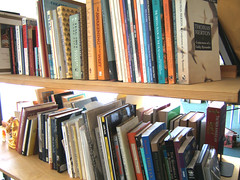
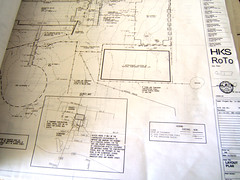


Fast forwarded Q & A's, (long hand)
OA: I am looking at this 1977 edition of Gebhart and Winter Guide to Architecture in Los Angeles.
Except Frank Gehry, none of you guys are in it yet, meaning, Morphosis, Eric Moss, Coy Howard, Mangurian-Hodgetts, Brian Murphy, Fred Fisher and others, all the young and restless mostly SCI Arc faculty.
I remember a photo in Venice Beach, on the sand, a crane shot by a Los Angeles Times photographer, showing you guys in a loose 'V' formation behind Gehry, in early 80's.
What made the world look at you guys during those years?
What made the Los Angeles architecture important again? What was the climate?
MR: The great advantage we had over our colleagues, in more established cities with certain ways of doing things, was that nobody was outraged with what we were doing. There was no opposition; nobody cared what happened in Venice Beach community. We have done things even against the building department's wishes. If they did not permit, we built them anyway. But nobody really cared, because that was an unsafe part of the city. The stuff was new and energetic. The eco system of Venice was full of wackiness. It was very fortunate time for all of us. We have just followed the path of least resistance.
I don't know. You can look back retrospectively and say this happened and this happened.
But, at the end it comes down to that we were all exploring.
OA: I was quite familiar with Morphosis and witnessing great energy that was generated from your office. It was like the extension of school. Your office was open 24 hours, I remember people like,
Tadao Ando, Zaha Hadid, Rem Koolhaas, Wim Wenders and others stopping by, if I am not mistaken. Your office was a happening place. A lot of action took place there. It was definitely formative period for everybody.
And Morphosis? You were together for seventeen years and you've split up. How's that happened?
MR: We were attracted to each other through the world we envisioned. They were great times to develop and evolve. Together we have come to age...
(he pauses)
After that, it was two practices branching out of one. What is difficult for many people to either comprehend or accept is that when one thing becomes two, the world likes to think that is a result of bad things.
OA: I don't think that.
MR: I think it is still the same genetic code, because what were your motivations then, in a very basic way, are still the motivations now. You are always trying to do things to surprise yourself because you do not want to repeat yourself.
For me, the experimentations now, are about social experimentations as much as are about architectural experimentations.
The relationships for me now are part of the programs. It is about work being a change agent. All the things I was interested as a child growing up, and in the formative years of SCI Arc, they manifest in architecture.
It is not about being in focus solely to make extraordinary buildings. It is about the creative process being used in developing and sustaining relationships, as well as the projects and the buildings.
It is not about changing things to my likeness necessarily but trying to be an agent for better world.
If you ask architects why they became architects, like, they are on a mission. They really believe the world can be better place than it is right now. And, as you get older, you might try to initiate that change
in a quieter and more subtle ways.
I long to reach a place where I make things without any concern that people know that I made those things but, they acknowledge their lives are better and different because of those things.
OA: Let's say, young architects today are finding out that, or complaining about, the human side, the better world side of their work is not happening. They are thinking that they can't make the world a
better place like you mention, what do you say to them?
MR: Part of the problem might be that they are not sure what they are looking for. They think it looks the certain way. It is not about making things look certain way, you have to be first yourself. Biggest project of all is, ourselves. It is not just a conceptual issue.
OA: You along with April Greiman, own a motel. Do you want to talk about it?
MR: Besides from soaking in the mineral water, and going walks in the desert, one of the main purposes of owning and running Miracle Manor is, to make a place that people can go and physically become little bit more healthy. And, in the same time and better effect their psyche, and they might bring that into the world. I intentionally made that a part of the practice. Architecturally the place is an experiment in making things almost invisible but in the same time, you feel them like when the sun or wind hits you. You cannot see it but feel what it does.
OA: I always wondered if that kind of invisibility can be a part of a formal architectural program? I think I know what you mean.
MR: Yes.
OA: Where are you going with your work?
MR: I have faith that my best work is ahead of me. It is not about the skill I have but about the insight that I am developing. It is the insights about our nature and humanity. Index for me is, I will become a better architect when I become a better teacher.
I am a teacher who practices architecture.
Same dedication I expect from the students, I have to expect from myself. Same life I expect from my clients, I have to live myself...
OA: So, you do the talk but it is essential to you, to do the walk?
MR: Yeah. They have to be inseparable. Who you are, and what you say, what you see, what you make is all the same. It is one thing. To be a teacher, is not to make people in your image, it is to help them become what they most naturally become. And, you create those conditions in some way.
OA: What would be your ideal project at this moment?
MR: I think designing schools.
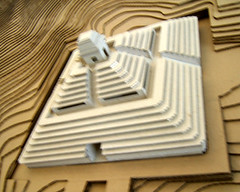

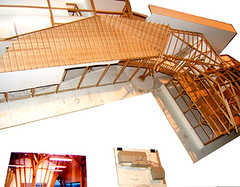
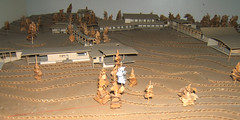
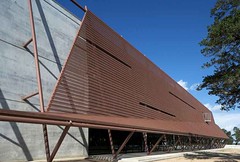
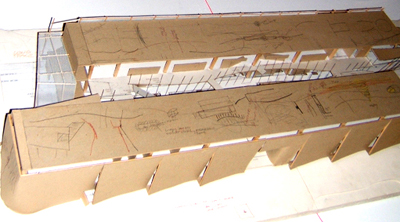
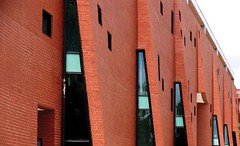
OA: The word I notice coming repeatedly from your students, interviews, articles etc, is 'section', which are cut through drawings of buildings, objects and organisms. Does that carry any significant meaning, relating to your work?
MR: Sections show you about the relationships of everything, not only the physical relationships, but also about the spatial relationships and than the conceptual relationships.
You see into things because of the section. And, because sections are drawn two dimensionally, you have to reconcile the two and the three D in your mind. It can only reconcile when you put your body in the space. So, body and the mind are now actively involved in the construction of that drawing.
It is essentially a drawing about integration.
OA: Are plans, sections?
MR: Plans are more like strategic drawings where you look for organizational strategies. Sections are more of like spatial strategies.
~~~
I thought of asking him more about his recent projects and I did.
However, at the end, to write about buildings alone was not possible.
I realized that for Mr. Rotondi, they were only a part of the overall practice.
Except the mostly never published snapshots of his office and work, I include here, I recommend visiting Roto web site to see his work through the different cameras.
In my opinion, his work is pretty much about 'life up front and everywhere else.'
Los Angeles, Feb, 2007
(For My friend Ali Acerol; Oct, 1949 - Feb, 2007)
A long-time contributor to Archinect as a senior editor and writing about architecture, urbanism, people, politics, arts, and culture. The featured articles, interviews, news posts, activism, and provocations are published here and on other websites and media. A licensed architect in ...
14 Comments
how would rotundi respond to my analogy ie my project is like hitchcock's rope, thazz right, one continuos shot. no editing. no deception. no filmic manipulation. extra points 4 me as the hitch was the king of storyboarding....
just an fyi, many of the navajo rug designs were actually designed by dead white men who set up the trading posts back in the daaaay.
Excellent O!
good read. thanks orhan
I heard the arrival story at the Salk Institute almost word for word 19 years ago at a lecture in Vancouver, BC I guess its still works.... its so true though.
I finally visited this the Salk INstitute this last year and I could totally relate to his thoughts.
thanks orhan...makes me miss sci-arc and michael.
i'd like to thank you guys too for reading it and i also like to thank mr. rotondi, his office, his students and javier arbona, marlin watson, paul petrunia, john jourden, richard johnson for their feedback on the early drafts and thank all the friends and readers who e mailed me about the article.
another great peice O! I still want to hear where Clark Stevens is these days... any clue?
RIP Ali...
Thanks Orhan. I finally took some time out of my day to read this, as I have been planning to do since it went up, and was well-rewarded. It is good to hear someone who pulls all his life experiences into the making of architecture - architecture and practice and life are not separate things, they all inform one another. And an acceptance of change and not putting enormous personal expectations on things beyond one's control.
He speaks several times about not putting his own stamp on things, but allowing them to follow their own course, and try to nurture that course. The definition of fostering growth, the good kind.
Excellent read.
very interesting, Orhan.
not an opinionated exposé, but not an a-positional interview either. Rotondi reminds me of the best of my teachers at UF. having read this feature makes me miss design school and appreciate the instructors that fostered self-discovery and imagination.
awesome, thanks Orhan..
you made me miss SCI-Arc and reminded me how special SCI-Arc is..
Quite interesting, Orhan. Thanks!!! Liberty Bell sums up most of my observations above. It's really great when you can combine Architecture with the Way You Live. That's what it is all about. That's why it's about the Art of Living and not about Art.
Incredible...I am in early stages of studying Architecture. You've taken my own inner hopes for self to new heights with this share. Incredibly interesting, thought-provoking and more than I ever expected of an intereview. This is in depth and I appreciate the glimpse into 'your' worlds. This is my first real interview within architecture that was this incredibly worth the read!
Many Thanks again,
Jeanine H
Cal Poly Pomona's 2014 Neutra Award goes to Michael Rotondi.
Block this user
Are you sure you want to block this user and hide all related comments throughout the site?
Archinect
This is your first comment on Archinect. Your comment will be visible once approved.